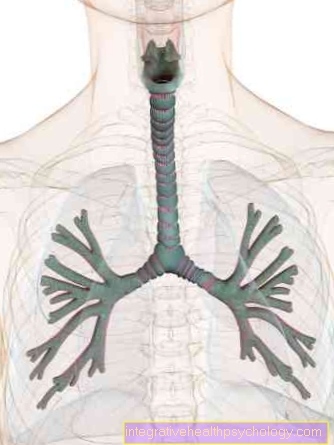Signs of tonsillitis
Synonyms
Tonsillar angina signs, tonsillar angina symptoms, tonsillitis symptoms
definition
The term tonsillitis is a painful inflammation of the tonsils (Tonsils) and the mucous membrane bordering it.
introduction

The oral cavity is an ideal habitat for a large number of bacterial pathogens, even in healthy people. When the immune system is balanced, these bacteria are not harmful and do not cause infections. However, if the immune system is severely impaired, for example due to an infection of the respiratory tract, then normally harmless bacterial pathogens can also assume disease-causing properties. In addition, bacteria from the surrounding area can enter the body through the mouth and nose. In this way, the pathogens have to pass through the tonsils, which are located in the pharynx immediately behind the lateral palatal arches. The most important function of the tonsils is the defense against bacterial and viral pathogens. For this reason, the tonsils are generally included in the lymphatic system. In people whose immune system is already severely weakened, the penetration of the bacteria can usually only be prevented inadequately. The bacterial pathogens can then settle in the tissue of the tonsils and multiply in an uncontrolled manner. As a result, inflammatory processes develop in the affected people, which can be associated with pronounced symptoms (signs of tonsillitis). In classic tonsillitis, a distinction must be made between an acute and a chronic form. Acute tonsillitis is usually transmitted by droplet infection, for example when coughing, sneezing, kissing or speaking. In the case of acute tonsillitis, the signs of which can be very pronounced, it is often a viral infection. However, the acute form of tonsillitis can also be caused by bacteria. Patients with acute tonsillitis notice the first signs just a few days after infection. Local swelling and reddening of the back of the throat are typical signs of acute tonsillitis. In addition, a purulent secretion can be deposited on the inflamed tonsils. Acute, purulent tonsillitis is a highly contagious disease that requires prompt medical clarification. Otherwise, the symptoms typical of this disease may increase and / or complications may arise. We always speak of so-called chronic tonsillitis when the inflammation in the area of the tonsils has persisted for more than three months. In contrast to acute tonsillitis, the signs of chronic tonsillitis can be much more variable.
Classification of different signs
The signs of tonsillitis depend on both the cause and the course of the inflammatory processes. For this reason, a distinction must be made between bacterial, viral, acute and chronic tonsillitis in the typical signs. In addition, the extent of the inflammatory processes plays a decisive role in the signs that occur.
Find out more about: Pus on tonsils
Signs of acute tonsillitis
A first sign of the acute Tonsillitis is often the sudden onset of fever and chills. In addition, the affected patients typically suffer from severe Sore throatthat can sometimes radiate into the ears. Other signs that are particularly common in acute tonsillitis are a headache and Discomfort when swallowing. These swallowing difficulties are caused by the swelling in the area of the throat and can be so pronounced that eating is only possible with pain. In addition, patients with acute inflammatory processes on the tonsils often have a "lumpy" pronunciation. In particularly severe cases, the swelling can even narrow the airways and thus close Shortness of breath to lead. In addition, there are general symptoms such as fever, chills, tiredness and fatigue. The clinical examination reveals other signs of acute tonsillitis. In the affected patients, both the tonsils and the back of the pharynx are usually markedly red and swollen. In the case of bacterial tonsillitis, there is also one white-yellowish, viscous mass, that covers the tonsils. This phenomenon is called "Pus", Which in very pronounced cases, these pus can merge and extend beyond the tonsils (confluent coverings). These confluent layers are often a typical sign of pneumococcal diseaseangina. In addition, the affected patients often report one with an acute tonsillitis unpleasant taste in the mouth (Foetor ex ore).
Signs of chronic tonsillitis

From one chronic tonsillitis can always be spoken of when the inflammatory processes in the area of the tonsils over one Period of more than three months persist or recur within a year. The typical signs of chronic tonsillitis differ significantly from the symptoms of acute tonsillitis. Patients who have chronic tonsillitis usually feel mostly Sore throat and slight difficulty swallowing. In addition, chronic tonsillitis can lead to an increase in body temperature. The fever However, compared to the acute form, it is usually less high. In general, it can be assumed that the signs of chronic tonsillitis are less pronounced. Since the symptoms of the chronic form are therefore rather discreet, possible swallowing difficulties are considered untypical by many of those affected Sore throat or Feeling of dryness dismissed. In addition, the affected patients often report a bad taste in the mouth, which is not improved by rinsing or brushing their teeth. The reason for this unpleasant taste is the inflammatory processes involved in the Formation of a purulent secretion can go hand in hand. In addition, the bad taste in the mouth of an affected person can be caused by metabolic end products of the primal bacteria. In addition, whitish spots, which do not necessarily have to be pus, are typical signs of chronic tonsillitis. Furthermore, depending on the severity of the disease, there may also be general signs. Individuals who suffer from chronic inflammation of the tonsils tend to be knocked off and tired. In addition, the chronic infection can lead to a general decreased performance and poor concentration to lead. In addition, enlargement of the lymph nodes in the neck and lower jaw is one of the most common signs of chronic tonsillitis. Since the symptoms appear so discreetly when chronic inflammatory processes of the tonsils are present, very few of the affected patients even seek medical advice. Under certain circumstances, this can lead to long-term impairment of immune performance and / or serious complications.
Signs of tonsillitis in HIV / AIDS
At HIV (human immunodeficiency virus; human immunodeficiency virus; HI virus) is one viral pathogenbelonging to the group of Retroviruses is counted. An untreated HIV infection leads to a varying length of time in which no symptoms occur (so-called Latency phase), usually too AIDS (acquired immunodeficiency syndrome; acquired immunodeficiency syndrome). The transmission of the HI virus (HIV) takes place mainly through the Exchange of semen or blood. For this reason, people who have unprotected sex or are drug addicts are particularly at risk of contracting HIV. The incubation period (The time from being infected with the HIV virus to the outbreak of AIDS) can vary widely and a period of time from a few months to more than 15 years accept. The length of this period of time can be influenced by virus-suppressing drugs as well as by the lifestyle and mental state of the person concerned. While there are only very few clear signs of infection in the course of HIV infection, typical symptoms occur when AIDS breaks out. Since AIDS is a disease that destroys the human immune system, affected patients usually tend to have one pronounced immune deficiency. Because of this, the recurrence of Tonsillitis (chronic tonsillitis) a first sign of HIV infection (AIDS) be. In this context, chronic tonsillitis is one of the most common signs that can occur in the early stages of AIDS. Since the immune system of an HIV patient is so badly attacked that any infection often leads to complications, bacterial tonsillitis in HIV should be treated early with penicillin.
Signs of cancer
Especially in the area of the transition from the oral mucosa to the pharynx there are important defense centers against bacterial and viral pathogenswho have favourited pharynx. Chronic inflammatory processes in the area of the pharynx (chronic tonsillitis) can for this reason in the long term burden the entire organism and therefore lead to a number of Secondary diseases and complications to lead. Although the tonsils are considered an important part of the human immune system, around 80 percent of the immune system is anchored in the intestine. Because of this, permanent impairment of the tonsils can have an impact on the health of the intestines. Conversely, chronic diseases of the intestine can also increase the risk of developing chronic tonsillitis. Through various mechanisms, for example Infections of the intestinal lining or cancer, it can also be pronounced Weakening of the body's immune system come. For this reason, too, the affected patients often develop recurring or long-lasting inflammatory processes in the area of the tonsils (chronic tonsillitis). Since above all malignant ulcers (Tumors) are counted among the most important diseases that weaken the immune system, recurrent tonsillitis can be a sign of cancer. However, not every location of a tumor has such an impact on the function and condition of the tonsils. Chronic tonsillitis can primarily serve as a sign of cancer in the intestine or pathological changes in the blood cells (blood cancer).
improvement
Which measures help to improve the signs of tonsillitis depends on both its cause and its course. Although severe difficulty swallowing One of the most common signs of tonsillitis is that getting enough fluids can improve the symptoms. This is especially true when young children and schoolchildren develop tonsillitis. In these patient groups it can quickly become one Dehydration (Dehydration) and an accompanying increase in signs. In addition, bed rest is one of the most important things you can do to improve the signs of tonsillitis. In the case of viral inflammation of the tonsils, treatment must be purely symptomatic. Administration of antibiotics is not effective in the affected patients. To improve the signs of viral tonsillitis are particularly suitable pain reliever drugs like paracetamol and ibuprofen. Since ibuprofen, unlike paracetamol, also has a anti-inflammatory component this medicinal product should be given preference. In addition, warm chamomile tea can also help to alleviate the signs of the inflammatory processes in the tonsils. In streptococcal angina, however, the improvement of the signs can be accelerated by giving an antibiotic.













.jpg)















